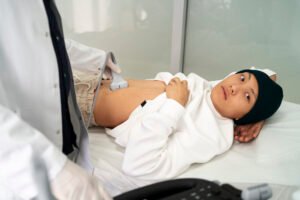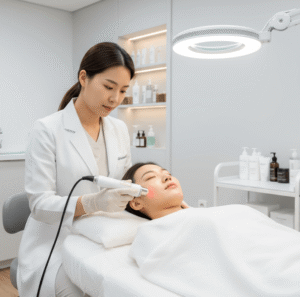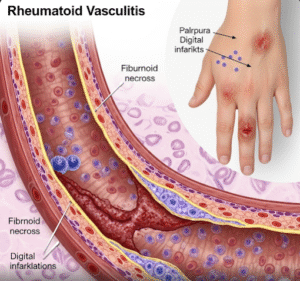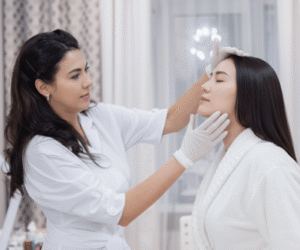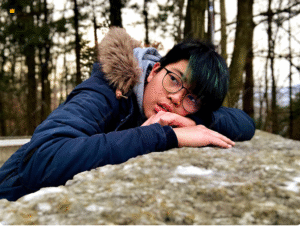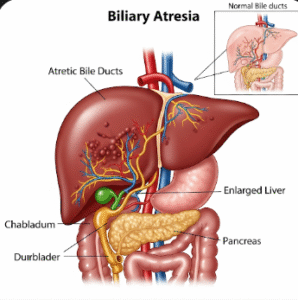What it is
➝ Ocular rosacea is a subtype of rosacea that affects the eyes and eyelids.
➝ It causes redness, burning, dryness, itching, and irritation in the eyes, along with swollen eyelids, recurrent styes, or chalazia.
➝ In more severe cases, it can lead to light sensitivity, blurred vision, corneal inflammation (keratitis), and long-term damage if untreated.
➝ Management of ocular rosacea requires a multidisciplinary approach involving dermatologists and ophthalmologists.
Why it’s done
→ To relieve eye discomfort, dryness, and irritation, which interfere with daily life.
→ To prevent corneal damage and vision loss, which can occur if inflammation is left untreated.
→ To manage eyelid inflammation (blepharitis) and reduce recurrence of styes or chalazia.
→ To improve quality of life, as ocular rosacea often occurs with skin rosacea and adds to the physical and emotional burden.
→ In Korea, ocular rosacea care emphasizes early diagnosis, long-term monitoring, and combined skin-eye treatment.
Alternatives
→ Lifestyle modifications:
- Avoiding triggers such as alcohol, spicy foods, heat, and stress.
- Using humidifiers in dry environments.
→ Home care measures:
- Warm compresses and gentle eyelid massages.
- Lid scrubs with diluted baby shampoo or commercial eyelid wipes.
→ Topical treatments:
- Lubricating eye drops (artificial tears).
- Antibiotic ointments (erythromycin, bacitracin) for eyelid inflammation.
→ Oral treatments:
- Low-dose doxycycline (anti-inflammatory effect).
- Azithromycin in certain resistant cases.
→ Procedural options:
- Intense Pulsed Light (IPL) therapy for meibomian gland dysfunction (MGD).
- Thermal pulsation devices (e.g., LipiFlow).
Preparation
→ A full eye examination is needed, often including slit-lamp evaluation, tear film assessment, and meibomian gland function tests.
→ Skin examination is also important, as ocular rosacea frequently coexists with facial rosacea.
→ Patients are advised to:
- Stop contact lens use during flare-ups.
- Maintain strict eyelid hygiene.
- Use preservative-free lubricating eye drops.
→ In Korea, many dermatology and ophthalmology clinics work collaboratively, ensuring patients receive integrated care.
How it’s Done
→ First-line care: Warm compresses, lid hygiene, and artificial tears to reduce dryness and irritation.
→ Oral doxycycline (low dose, anti-inflammatory, not antibiotic strength) may be prescribed for moderate to severe cases.
→ Topical antibiotic ointments (applied to eyelid margins) help reduce bacterial overgrowth and inflammation.
→ Steroid eye drops may be used short-term in severe inflammation but require close ophthalmologist supervision.
→ Advanced clinics in Korea may combine medical therapy with procedures like IPL therapy to improve meibomian gland function.
Recovery
→ Symptom improvement (less dryness, less irritation) often begins within 2–4 weeks of consistent care.
→ Full control of ocular rosacea may take 2–3 months, depending on severity.
→ Patients typically experience reduced redness, fewer styes, and improved tear film stability.
→ Long-term management and maintenance therapy are often needed, as ocular rosacea is chronic and relapsing.
Complications
→ Untreated ocular rosacea can lead to:
- Chronic blepharitis (eyelid inflammation).
- Meibomian gland dysfunction (blocked oil glands).
- Corneal ulcers or scarring.
- Permanent vision damage in severe cases.
→ Medication-related risks:
- Prolonged steroid eye drop use may cause glaucoma or cataracts.
- Oral doxycycline may cause photosensitivity or stomach upset.
Treatment Options in Korea
→ In Korea, ocular rosacea care is typically multidisciplinary, with dermatologists and ophthalmologists working together.
→ Many eye clinics integrate advanced dry eye management systems (IPL, thermal pulsation therapy, meibomian gland probing).
→ Dermatology clinics provide parallel treatment for skin rosacea, ensuring both facial and ocular symptoms are managed.
→ Patients often receive personalized skincare routines, gentle cleansers, and sun protection advice alongside ocular therapy.
→ Korean clinics also emphasize education on daily eyelid hygiene, encouraging long-term habits like warm compresses and lid scrubs.
→ With Korea’s reputation for advanced ophthalmology and dermatology, patients have access to comprehensive, modern care that combines medical, lifestyle, and procedural strategies for long-term control of ocular rosacea.




